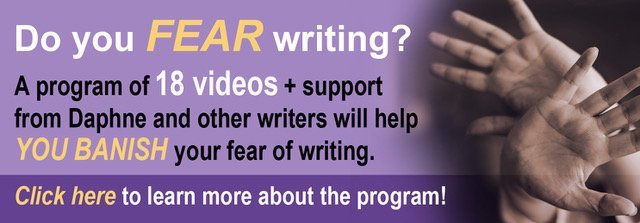Reading time: About 3 minutes
Do you hem and haw? Feel jittery? Wring your hands? Or do you already know how to make good writing decisions?
When I was in my mid-30s, I sat down to make a decision that would change the course of my life.
I had given birth to triplets in 1994 and had recently returned to work (which I considered “a chance to catch my breath,” given all I had going on at home.) But my employer, a newspaper chain, had recently been bought out by a high-flying businessman who was unfriendly to journalists. And there was a buyout offer on the table.
I could continue to work, doing a job I loved, or I could take the money and run.
My sleep-deprived state made the decision easy. I ran.
You may also have some momentous writing-related decisions you need to make:
- Should you reduce the hours on your non-writing job to allow yourself more time for writing?
- Is it a good idea to hire a professional to edit your book?
- Can you make your computer limp along for another year or should you buy a new one?
- Should you spend time and money looking for an agent or does it make more sense to self-publish?
- Would it be a good idea to switch genres?
When faced with questions like these, many of us tend to make pro and con lists and, because we usually feel uncomfortable in states of “limbo,” we like to make our decisions relatively quickly.
But research over the last 40 years reveals this approach is often a mistake. We make up our minds too quickly and we don’t usually generate enough options for ourselves.
“Yes or no” questions offer a simple fork in the road. But “which way should I go?” questions almost always lead to a better result.
Business professor Paul Nutt discovered this reality in the 1980s, when he analyzed decisions made by senior managers at a range of public and private organizations in the United States and Canada.
Here’s what he found: Only 15 per cent of the decision-makers actively sought out a new option beyond the initial choices. And people with more options almost always make better choices.
If you want to expand your options, it helps to expand the group of people helping make them. So, put together an advisory group and make sure it’s as diverse as possible. Look for a mix of people from different educational backgrounds, races, genders, income levels. People with different backgrounds are going to have different ideas, helping you to broaden your choices.
And here’s an interesting P.S. to the diversity question: A 2008 study by the management professor Katherine Phillips showed that while more diverse groups made better decisions, they were also far less confident in the decisions they made. Even though they were more likely to be right, they were more open to the idea that they might be wrong. (In case this needs to be said, that’s a benefit rather than a detriment.)
If you really want to sharpen your decision-making technique, consider using a tool developed by psychologist Gary Klein. He calls it the premortem. Different from a post-mortem, which takes place when someone has died, a premortem imagines a future in which you’ve carried out your plan. And it’s failed. Your job now is to figure out why.
A premortem tends to be more successful than other types of decision analysis because it forces us to imagine actual scenarios where the decision turned out to be disastrous. As you engage in this exercise, reflect on your personal biases and patterns over time. What are the mistakes you’ve made in the past? How can your knowledge of these “typical” mistakes inform your premortem?
Finally, here’s a last useful trick: Remove yourself from the decision-making tree. Imagine that you’re making this decision on behalf of a friend or a client. We often give different — better — advice to our friends than we give to ourselves. Using this outside perspective will also help you keep your emotions in check.
Returning to my life-altering decision of 28 years ago, my husband and I soon realized that while I hadn’t made a mistake, I hadn’t fallen upon the best decision either.
I needed to return to work to be able to help pay for our massive mortgage. And I wanted to because I found 24-7 childcare to be mind-numbing.
If, instead of asking “yes or no?” I had asked, “which way should I go?” I would have realized sooner that working part-time from home would be a much better solution for our family.
If we’d spoken with our banker or a financial planner, they’d probably have told us the same thing.
If I’d done a premortem and forced myself to confront the likelihood of our cash flow problem, I would have made a different decision.
If I’d used a more diverse group to help me make this decision, I would have been given more ideas.
If I’d pretended I was making the decision for a friend, I almost certainly would have recommended what I ended up doing.
Yes, it all worked out in the end. And I’m thrilled that that decision, in a round-about way, has delivered my post to your inbox today.
But it could have worked out even sooner, if I’d been more mindful about how I made that decision.
*
My video podcast last week addressed the dealing with verbal tics when public speaking. Go here to see the video or read the transcript, and you can also subscribe to my YouTube channel.
*
Need some help developing a better writing routine? Learn more about my Get It Done program. Priority will go to those who have applied first. You can go directly to the application form and you’ll hear back from me within 24 hours.
*
How do you make better writing decisions? We can all learn from each other so, please, share your thoughts with my readers and me in the “comments” section below. Anyone who comments on today’s post (or any others) by May 31/23 will be put in a draw for a digital copy of my first book, 8 1/2 Steps to Writing Faster, Better. To enter, please scroll down to the comments, directly underneath the “related posts” links, below. Note that you don’t have to join Disqus to post. See here to learn how to post as a guest. It’s easy!


